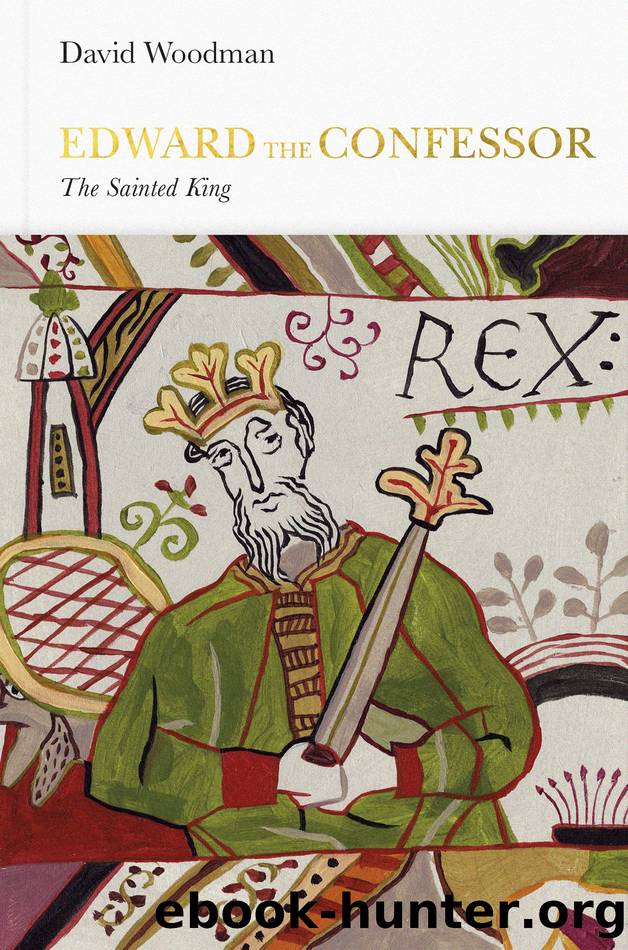Edward the Confessor by David Woodman

Author:David Woodman [Woodman, David]
Language: eng
Format: epub
ISBN: 9780241383025
Publisher: Penguin Books Ltd
Published: 2020-11-05T00:00:00+00:00
It is clear from the details in this vision and the way in which they are expressed that reference is being made to the cataclysmic events that transpired with the Norman conquest, and that the author must therefore be writing this part of the text in full knowledge of how things turned out after Edward had died. In discussing the prophecy further, the author comments that Edwardâs vision (of the green tree) was unlikely to be fulfilled: no tree, split into parts in the way described, could ever be made whole and healthy once again without some kind of intervention. The allegorical message is that, for as long as the English people would not repent, they could not hope for remission of their sins, with the result that the punishment sent from God in the form of the Norman invaders would be an enduring one.56 This prophecy was recast by authors later in the twelfth century in a much more positive light, as we shall see in the next chapter. But, taken in its eleventh-century form, it is remarkable for its demonstration of the bleak outlook that was felt in some quarters following the end of Edwardâs reign.
The Vita Ãdwardi contains a description of those who were present to hear the prophecy uttered by the dying Edward. They included Queen Edith, who was at Edwardâs feet, Earl Harold, Robert fitzWimarch (a high-ranking secular official), Stigand (now Archbishop of Canterbury) and a few more who are not named but whose presence was requested by Edward when he awoke.57 The Bayeux Tapestry, thought to be near-contemporary with the Vita, includes a scene which relies on this literary account for its depiction of Edward as he lay on his deathbed. The scene itself is one of the few in the Tapestry to be divided into two parts, with each unfolding within the confines of the same building. In the scene in the upper part we find Edward lying in bed, his head propped up by a man who may be Robert fitzWimarch while he speaks to a noble who may be Earl Harold; there is also a woman, who may be Edith, weeping at his feet and a priest, who could be Stigand, standing on the other side of the bed.58 The scene is framed by the inscription: Hic Eadwardus rex in lecto alloquitur fideles (âHere King Edward, in bed, speaks to his faithful followersâ). In the lower part Edward has died, announced by the inscription Et hic defunctus est (âAnd here he is deadâ); he is now being prepared for burial by two attendants while a priest, who may once again be Stigand, looks on. The compression of the scene into two parts might be an artistic device intended to convey the rapidity with which Edwardâs health deteriorated. The Anglo-Saxon Chronicle, having told us that he had become so unwell by 28 December 1065 that he was unable to attend the consecration of Westminster Abbey, then records that Edward died shortly later,
Download
This site does not store any files on its server. We only index and link to content provided by other sites. Please contact the content providers to delete copyright contents if any and email us, we'll remove relevant links or contents immediately.
| Africa | Americas |
| Arctic & Antarctica | Asia |
| Australia & Oceania | Europe |
| Middle East | Russia |
| United States | World |
| Ancient Civilizations | Military |
| Historical Study & Educational Resources |
Magic and Divination in Early Islam by Emilie Savage-Smith;(1492)
Ambition and Desire: The Dangerous Life of Josephine Bonaparte by Kate Williams(1329)
Bohemians, Bootleggers, Flappers, and Swells: The Best of Early Vanity Fair by Bohemians Bootleggers Flappers & Swells- The Best of Early Vanity Fair (epub)(1324)
Papillon by Henry Charrière(1298)
Twelve Caesars by Mary Beard(1231)
Operation Vengeance: The Astonishing Aerial Ambush That Changed World War II by Dan Hampton(1128)
What Really Happened: The Death of Hitler by Robert J. Hutchinson(1113)
London in the Twentieth Century by Jerry White(1097)
Time of the Magicians by Wolfram Eilenberger(1074)
Twilight of the Gods by Ian W. Toll(1071)
The Japanese by Christopher Harding(1067)
Lenin: A Biography by Robert Service(1027)
The Devil You Know by Charles M. Blow(972)
A Social History of the Media by Peter Burke & Peter Burke(926)
Freemasons for Dummies by Hodapp Christopher;(911)
Napolean Hill Collection by Napoleon Hill(890)
Henry III by David Carpenter;(882)
The Churchill Complex by Ian Buruma(874)
The Rise and Triumph of the Modern Self by Unknown(872)
